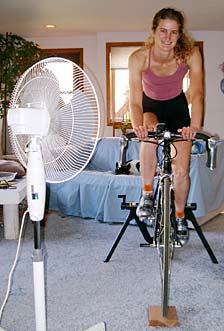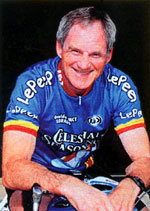Indoor Cycling, The Basics
By Fred Matheny
Most cyclists love to be outdoors, even in winter. After all, fresh air, sunshine and scenery are big attractions of the sport. If we wanted to exercise inside, we'd all become gym rats.
 Indoor cycling is usually considered a last resort when weather makes it unpleasant to ride outside but many coaches recommend trainer workouts even if the sun is shining. "I'm a big fan of indoor trainer," says Chris Carmichael (a top American coach). "Indoor training is a necessity in winter, but I prescribe it to my riders all year round."
Indoor cycling is usually considered a last resort when weather makes it unpleasant to ride outside but many coaches recommend trainer workouts even if the sun is shining. "I'm a big fan of indoor trainer," says Chris Carmichael (a top American coach). "Indoor training is a necessity in winter, but I prescribe it to my riders all year round."
The benefits can be great, but there's a big problem: boredom. Watching sweat drip off your nose while hammering in your basement isn't quite as much fun as a spirited training ride in midsummer. But if you know a few tricks, indoor training is not only bearable but almost enjoyable. Because the trainer makes workouts predictable and repeatable, it's a great workout tool as well.
Advantages
- Train at any hour, day or night.
- Ride despite rotten winter weather.
- Save time. Dressing and undressing for outside rides takes precious minutes. Then you may have to spend more time washing and lubing your bike.
- Safety. When you ride indoors, there's no treacherous ice or traffic to pose a threat.
- Seize control. Riding a trainer allows you to precisely monitor each workout. That's why coaches love it. It's controllable and predictable so you can duplicate workouts and find out exactly how much you're improving. You determine the time and intensity of every session. Outside, all sorts of things can interfere. Plus, it's difficult and even dangerous to ride vigorously in frigid air. Winter clothes are restrictive. It's hard to warm up well in order to reduce the risk of injury. Once you do work up a sweat, a cold chill can set in to make the rest of the ride uncomfortable.
- Remember how to pedal. Spinning on a trainer after a crosstraining workout of weights, running, skiing or any other activity helps you retain your pedal stroke. It loosens leg muscles, too, reducing the soreness that can result from launching into unaccustomed, weight-bearing exercise.
Tips for successful indoor rides
Does it sound like I'm trying to talk you into something? Despite all the advantages I know that indoor training can be terminally boring. Time passes at a snail's pace because your mind isn't occupied with everything necessary to keep a 2-wheeled vehicle upright and on course. Indoor riding creates sensory deprivation equal to any devised in a psychology experiment. However, with the right approach, time on the trainer can be coaxed to flow along at normal speed. Here are some effective ways:
- Limit your riding time. An indoor trainer isn't for off-season endurance workouts. I'll bet most riders try at least once to ride their nowhere bike for 3 hours while watching football or reading War and Peace. They find out that once is more than enough. It's not very effective training, either. Crosstraining is a much better way to get off-season aerobic conditioning. So on the trainer, limit each workout to 60 minutes. Get on, warm up, do your workout, cool down and call it good. A trainer works great for short, intense, structured workouts. It becomes a torture machine for long steady-state rides.
- Vary every workout. Never do the same thing on a trainer for more than a few minutes at a time. Shift gears, stand up, pedal with one leg, go hard, go easy — anything to give your body and mind a break.
- Keep your mind occupied. On a trainer, your brain wants to dwell on time and discomfort. Stimulate it with music, movies, TV sports or even, if you're really desperate, soap operas or quiz shows. I like watching bike races. I tape the Giro, Tour and spring classics to use during the winter.
- Stay cool. Without a cooling wind, you'll heat up quickly while riding in your own stale indoor air. So, put a large fan a few feet in front of your face (photo) to create an artificial headwind. The stream of air will help evaporate the quarts of sweat you produce, keeping your core temperature down for a better, more comfortable workout. This is important, as indicated by the result of a recent lab study: Endurance time on a cycle ergometer at an intensity that could be maintained for 92 minutes when the temperature was 52 degrees decreased to 83 minutes at 70 degrees and to only 51 minutes at 86 degrees. The cooler you can make the indoor cycling environment, the more work you can do — and the greater fitness you can gain.
|
EXAMPLE! Steve Johnson, the head of USA Cycling, used to do his winter training in a janitor's closet at the University of Utah, where he headed the Human Performance Lab. Without air flow, his body heat would have quickly turned the closet into an oven. But with 2 big box fans blowing directly in his face, he kept his cool — and was able to build on his winter fitness to win the masters world road championship. |
- Drink up. Down at least one big bottle per hour while on the trainer, just like outside during a hot summer ride. Sports drinks work better than water because they replace carbohydrate, extending your energy.
- Train with others. Sign up for a cycling class at your local health club. Generically called "spinning" classes, these group hammer-fests are a great way to add variety and interest to your indoor riding and meet other fitness enthusiasts as well. Another approach is to start a "trainer night" at your home. San Diego cycling coach Arnie Baker, M.D., invites up to 70 members of the CycleVets club to his house one evening per week. They set up trainers on the patio and go through a specific workout. Then they order pizza and socialize.
- Study your form. A great way to improve your relaxation and form while training indoors is placing a large mirror where you can watch yourself while you're riding and ensure that you're maintaining a comfortable and efficient position.
|
TIP! This article is devoted to making the most of indoor cycling, but you should know that experienced riders usually don't get on their trainer frequently in the winter. They know that stationary cycling can be mentally taxing. If they use up their store of enthusiasm in January, they'll hate getting on the trainer in spring when bad weather interferes with riding the road. Instead, they crosstrain in winter and save the trainer for spring. Then when they need a hard workout but can't get outside, they don't mind climbing on their nowhere bike. |
 This Signature Series article is provided courtesy of RoadBikeRider.com. It comes from RoadBikeRider's bible of training for cycling, Fred Matheny's Complete Book of Road Bike Training by Fred Matheny.
This Signature Series article is provided courtesy of RoadBikeRider.com. It comes from RoadBikeRider's bible of training for cycling, Fred Matheny's Complete Book of Road Bike Training by Fred Matheny.
From the cover: During three decades as a road rider and cycling writer, Fred Matheny has built an international reputation for his contributions to the sport. In this, his thirteenth book, he amasses his knowledge and that of many other experts in what is truly the complete book of road bike training.
RoadBikeRider offers Fred's book, many more cycling guides and even a free weekly e-mail newsletter full of tips and news for aspiring bicyclists.
